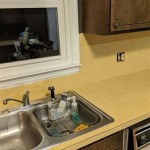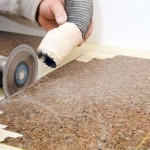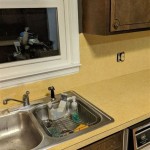How To Clean Countertop Grout Effectively
Countertop grout, the porous material filling the spaces between tiles, is susceptible to staining and discoloration. Its inherent texture and composition make it a breeding ground for mold, mildew, and trapped food particles. Regular cleaning is essential to maintain a hygienic and aesthetically pleasing countertop surface. The following details a comprehensive guide on effectively cleaning countertop grout, outlining various methods and preventative measures.
Understanding Grout Composition and Cleaning Challenges
Grout is typically composed of cement, sand, and water, sometimes with added polymers for enhanced durability. This composition results in a porous material that easily absorbs liquids and stains. Spills from coffee, juice, wine, and oily foods can penetrate the grout, leading to stubborn discoloration. Mold and mildew thrive in damp environments, making kitchen and bathroom countertops particularly vulnerable. Furthermore, the texture of the grout provides numerous crevices where dirt and grime can accumulate, making removal difficult. Traditional cleaning methods often fail to address these challenges adequately, leading to temporary solutions that do not eliminate the underlying problem.
The selection of appropriate cleaning agents is critical to avoid damaging the grout or the surrounding tiles. Acidic cleaners, while effective for removing certain types of stains, can etch and weaken grout over time. Abrasive cleaners can scratch the tile surfaces, diminishing their shine. Understanding the specific properties of different cleaning agents and their potential impact on grout and tile is paramount for effective and safe cleaning.
The frequency of cleaning depends on the level of use and exposure to spills and moisture. High-traffic areas and countertops prone to frequent spills require more frequent cleaning than less-used surfaces. Implementing a regular cleaning schedule can prevent stains from becoming deeply embedded and minimize the growth of mold and mildew.
Effective Cleaning Methods for Countertop Grout
Several methods can be employed to clean countertop grout, ranging from simple home remedies to specialized cleaning products. The choice of method depends on the severity of the staining and the type of grout. A systematic approach, starting with gentler methods and progressing to stronger solutions if necessary, is recommended to minimize the risk of damage.
1. Warm Water and Mild Dish Soap: This is the gentlest and most versatile cleaning method, suitable for routine maintenance and light staining. Mix warm water with a small amount of mild dish soap. Apply the solution to the grout lines using a sponge or soft brush. Allow the solution to sit for a few minutes to loosen dirt and grime. Scrub the grout lines gently with the brush, paying attention to areas with visible staining. Rinse thoroughly with clean water and dry with a clean cloth. This method is effective for removing surface dirt and preventing the buildup of grime, but may not be sufficient for tackling deep-seated stains or mold.
2. Baking Soda Paste: Baking soda is a mild abrasive that can effectively remove stains without damaging the grout. Mix baking soda with water to create a thick paste. Apply the paste to the grout lines and allow it to sit for several minutes. Scrub the grout lines with a toothbrush or stiff brush. Rinse thoroughly with clean water and dry with a clean cloth. Baking soda is particularly effective for removing grease stains and light discoloration. The abrasive action helps to lift dirt and grime from the porous surface of the grout.
3. Vinegar and Water Solution: Vinegar is a natural disinfectant and stain remover that can effectively clean grout. Mix equal parts white vinegar and water in a spray bottle. Spray the solution onto the grout lines and allow it to sit for several minutes. Scrub the grout lines with a brush. Rinse thoroughly with clean water and dry with a clean cloth. Vinegar is effective for removing mold, mildew, and hard water stains. However, it is important to note that vinegar is acidic and can potentially damage certain types of grout over time, so it should be used sparingly and with caution.
4. Baking Soda and Vinegar Combination: This method combines the abrasive power of baking soda with the disinfecting properties of vinegar for a more potent cleaning solution. Sprinkle baking soda onto the grout lines. Spray vinegar onto the baking soda, creating a fizzing reaction. Allow the mixture to sit for several minutes. Scrub the grout lines with a brush. Rinse thoroughly with clean water and dry with a clean cloth. The fizzing action helps to loosen dirt and grime, while the baking soda and vinegar work together to remove stains and disinfect the grout. This method is effective for tackling more stubborn stains and mold growth.
5. Hydrogen Peroxide: Hydrogen peroxide is a mild bleaching agent that can effectively lighten stains and kill mold and mildew. Apply hydrogen peroxide directly to the grout lines and allow it to sit for several minutes. Scrub the grout lines with a brush. Rinse thoroughly with clean water and dry with a clean cloth. Hydrogen peroxide is particularly effective for removing coffee stains and other dark stains. It is also a good option for disinfecting grout. However, it is important to test hydrogen peroxide on a small, inconspicuous area first to ensure that it does not discolor the grout.
6. Commercial Grout Cleaners: Numerous commercial grout cleaners are available, formulated with stronger chemicals for tackling tough stains and mold. When using commercial grout cleaners, carefully follow the manufacturer's instructions. Wear gloves and eye protection to avoid skin and eye irritation. Ensure adequate ventilation to prevent inhalation of fumes. Test the cleaner on a small, inconspicuous area first to ensure that it does not damage the grout or tile. These cleaners often contain bleach or other harsh chemicals, so it is important to use them with caution and only when other methods have failed.
7. Steam Cleaning: Steam cleaners use hot steam to loosen dirt and grime from grout without the need for chemicals. Direct the steam nozzle along the grout lines, allowing the steam to penetrate the porous surface. Wipe away the loosened dirt and grime with a clean cloth. Steam cleaning is an effective and environmentally friendly option for cleaning grout. The high temperature of the steam kills mold and mildew, leaving the grout clean and disinfected.
Tools and Techniques for Effective Grout Cleaning
The effectiveness of grout cleaning depends not only on the cleaning method but also on the tools and techniques employed. Using the right tools and techniques can significantly improve the results and minimize the effort required.
1. Brushes: A variety of brushes are available for cleaning grout, each designed for different purposes. Stiff-bristled brushes are effective for scrubbing grout lines and removing stubborn dirt and grime. Toothbrushes are useful for reaching tight corners and crevices. Grout brushes with angled heads are designed to clean grout lines efficiently. Choose a brush that is appropriate for the type of grout and the severity of the staining.
2. Sponges: Sponges are essential for applying cleaning solutions and rinsing the grout. Use a clean sponge to apply the cleaning solution to the grout lines. Use a separate clean sponge to rinse the grout with clean water. Microfiber sponges are particularly effective for absorbing dirt and grime.
3. Microfiber Cloths: Microfiber cloths are ideal for drying countertop grout. They are highly absorbent and leave a streak-free finish. Use a clean microfiber cloth to dry the grout after cleaning.
4. Grout Rakes: Grout rakes are specialized tools designed to remove loose or damaged grout. They are useful for preparing grout lines before applying new grout. Use a grout rake to remove any loose or crumbling grout before cleaning. This will allow the cleaning solution to penetrate the grout more effectively.
5. Proper Scrubbing Technique: The scrubbing technique can significantly impact the effectiveness of grout cleaning. Use firm, even pressure when scrubbing the grout lines. Work in small sections, overlapping each section to ensure thorough cleaning. Scrub in a back-and-forth motion, following the direction of the grout lines. Avoid scrubbing too aggressively, as this can damage the grout or the surrounding tiles.
6. Rinse Thoroughly: Rinsing thoroughly is essential for removing all traces of the cleaning solution. Residue from cleaning solutions can attract dirt and grime, leading to faster re-staining. Rinse the grout lines with clean water until all traces of the cleaning solution are gone. Use a sponge or cloth to wipe away any excess water.
Preventative Measures to Minimize Grout Staining
Preventing grout staining is often easier than removing it. Implementing preventative measures can significantly reduce the frequency and intensity of cleaning required.
1. Regular Cleaning: Frequent light cleaning is more effective than infrequent heavy cleaning. Wipe up spills immediately to prevent them from penetrating the grout. Clean the countertops regularly with a mild cleaning solution to prevent the buildup of dirt and grime.
2. Sealing Grout: Sealing grout creates a protective barrier that prevents liquids and stains from penetrating the porous surface. Apply a grout sealer according to the manufacturer's instructions. Reapply the sealer every year or as needed to maintain its effectiveness. Sealing the grout is one of the most effective ways to prevent staining.
3. Using Cutting Boards: Using cutting boards when preparing food protects the countertops from spills and stains. Cutting boards provide a barrier between the food and the countertop, preventing liquids and food particles from coming into contact with the grout.
4. Preventing Moisture: Moisture promotes the growth of mold and mildew. Ensure adequate ventilation in kitchens and bathrooms to reduce humidity. Wipe up any spills or excess moisture immediately. Consider using a dehumidifier in areas with high humidity.
5. Choosing Darker Grout Colors: Darker grout colors are less likely to show stains than lighter colors. When installing new countertops, consider choosing a darker grout color to minimize the appearance of stains.

How To Maintain Kitchen Counter Tops Tile Grout Cleaning Sealing Caulking Services For Denver

How To Clean Kitchen Counter Tile Grout Tonya Staab

How To Clean Kitchen Counter Tile Grout Tonya Staab

How To Clean Grout 5 Popular Methods Remove

How To Clean Countertops The Home

How To Clean White Kitchen Tile Grout I Property Management

How To Clean Grout The Easy Way

Ultimate Grout Cleaning Kit Extra Large Tile Clean Eez

How To Professionally Clean Your Grout Without Getting On Hands Knees

Hard Surface Cleaning Detailing Tool Counter Top Revolution








